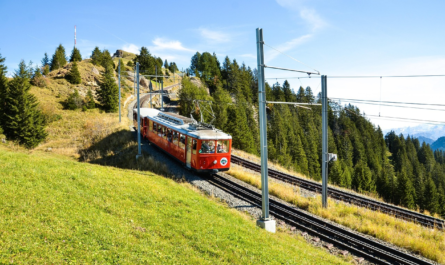Switzerland is synonymous with wonderful alpine landscapes, rich cultural traditions, and, of course, world-renowned cheese. While the country is home to numerous dairy regions, one of the most overlooked yet significant contributors to its cheese-making heritage is Mount Rigi.
This towering peak, nestled between Lake Lucerne, Lake Zug, and Lake Lauerz, has long been a cornerstone of Swiss dairy farming. The mountain’s fertile pastures, diverse flora, and fresh alpine climate play a pivotal role in producing some of the finest cheeses in the world. But how exactly does Mount Rigi contribute to Swiss cheese-making?
Let’s explore the deep-rooted connection between this iconic mountain and Switzerland’s legendary cheese.
Mount Rigi: A Paradise for Dairy Farming
Geography and Climate: A Perfect Cheese-Making Environment
Mount Rigi stands at 1,798 meters (5,898 feet) above sea level, offering breathtaking panoramic views of the surrounding Alps and valleys. But beyond its stunning scenery, its unique geographical and climatic conditions create an ideal environment for dairy farming.
The key factors that make Mount Rigi perfect for cheese production include:
- Lush Alpine Meadows: The mountain is covered in nutrient-rich grasses, wildflowers, and herbs, providing cows with a diverse and natural diet.
- Pure Mountain Air and Water: The high-altitude environment ensures clean, unpolluted air and fresh spring water, both of which contribute to the high quality of milk.
- Stable Temperature Variations: The difference in daytime and nighttime temperatures helps regulate the fat content in milk, essential for cheese texture and flavor.
These elements combine to produce milk with a rich, creamy texture—the foundation of Switzerland’s premium cheeses.
A Historical Legacy: The Role of Mount Rigi in Swiss Cheesemaking
Cheesemaking has been a part of Switzerland’s culture for centuries, with records dating back to the medieval period. Farmers in the Mount Rigi region have passed down traditional cheesemaking techniques for generations, preserving the authenticity and quality of their craft.
1. Alpine Cheese Production: A Centuries-Old Tradition
During the summer months, Swiss farmers engage in Alpwirtschaft—a traditional practice of moving cattle to higher-altitude pastures (Alpen) to graze on the freshest grasses. This seasonal migration ensures that cows get the best nutrition, which in turn enhances the quality of their milk.
The milk is then used to produce Alpkäse (Alpine Cheese), which is highly prized for its deep, earthy flavors.
2. Swiss Cheese Maturing in Mountain Caves
A fascinating aspect of cheese production in the Mount Rigi region is the use of natural mountain caves for aging cheese. These caves offer the perfect humidity and temperature conditions for cheeses like Sbrinz and Bergkäse, allowing them to develop a rich, complex flavor over time.
The Unique Flavors of Rigi’s Cheeses
The distinct taste of Swiss cheese comes from terroir—a French term that refers to the natural environment in which food is produced, including soil, climate, and farming traditions. The diverse flora of Mount Rigi influences the taste of its cheeses, making them uniquely nutty, floral, and aromatic.
Notable Swiss Cheeses Produced in the Mount Rigi Region
Rigi Bergkäse (Rigi Mountain Cheese)
- A semi-hard cheese made from raw cow’s milk.
- Aged for 4 to 12 months to develop a smooth texture and a mildly tangy, nutty taste.
- Often used in fondue and raclette.
Emmental (The Classic “Swiss Cheese”)
- Recognized by its large holes (eyes) created by bacteria releasing carbon dioxide during fermentation.
- Has a mild, slightly sweet, and nutty flavor with hints of the mountain’s herbs.
- A staple in sandwiches, soups, and cheese platters.
Sbrinz (Switzerland’s Parmesan)
- A hard, aged cheese known for its granular texture and intense umami flavor.
- Aged for 2-3 years in Mount Rigi’s natural caves.
- Used in grating over pasta, risotto, or eaten in thin slices as an appetizer.
Alpkäse (Alpine Cheese)
- A seasonal cheese made exclusively from cows grazing in high-altitude pastures during the summer months.
- Known for its deep, rich, and slightly smoky taste, thanks to traditional copper kettle production.
- A protected designation cheese (PDO), ensuring its authenticity.
Mount Rigi: A Destination for Cheese Lovers
Mount Rigi isn’t just a producer of world-class cheese—it’s also a must-visit destination for food lovers, travelers, and culture enthusiasts. Visitors can experience authentic Swiss cheesemaking through:
1. The Rigi Cheese Trail
A scenic hiking route that takes visitors through local dairies, alpine pastures, and traditional cheese huts. Along the way, you can sample freshly made cheeses and watch farmers at work.
2. Traditional Cheese-Making Workshops
Several local dairy farms around Mount Rigi offer hands-on cheese-making experiences, where visitors can:
- Milk cows and learn about the milking process.
- Make cheese from scratch, using traditional methods.
- Taste different aged cheeses, understanding how time affects flavor.
3. Farm-to-Table Dining
No trip to Mount Rigi is complete without indulging in traditional Swiss cheese dishes, such as:
- Fondue – A hot, melted cheese dish served with bread and potatoes.
- Raclette – Melted cheese scraped over boiled potatoes, pickles, and cured meats.
- Älplermagronen – Swiss alpine macaroni made with cheese, onions, and applesauce.
A Hidden Treasure in Swiss Cheese-Making
While Switzerland is globally renowned for its iconic cheese-producing regions like Gruyère, famous for its smooth texture and nutty flavor, and Appenzell, with its firm and tangy cheese varieties, Mount Rigi remains one of the country’s best-kept secrets in the world of cheesemaking. This charming mountain, nestled in the heart of central Switzerland, offers a unique blend of untouched natural beauty, centuries-old agricultural practices, and exceptional terroir that make it a key player in the nation’s rich cheese heritage.
The pristine alpine pastures of Mount Rigi, rich with a diverse mix of wildflowers and fresh herbs, provide cows with a balanced and nutrient-dense diet, which directly contributes to the richness and complexity of the milk. This high-quality milk, combined with the pure alpine air and the clean mountain water, offers the ideal foundation for the creation of Swiss cheese with exceptional flavors—flavors that reflect the very essence of the mountain landscape.
Moreover, Mount Rigi is not just a location for cheese production; it’s a symbol of Switzerland’s deep-rooted agricultural traditions. The methods used to produce cheese here—many of which have been passed down through generations—are grounded in local knowledge and handcrafted expertise. Farmers still follow traditional methods, from milking cows by hand to aging cheese in the cool, humidity-controlled mountain caves, where cheeses like Sbrinz and Rigi Bergkäse mature to perfection over several months. This process ensures the authenticity of Swiss cheeses, making them stand out in flavor, texture, and quality.
For cheese lovers, travelers, and food enthusiasts, visiting Mount Rigi offers more than just a chance to taste some of Switzerland’s finest dairy products—it’s an immersive experience that brings you closer to the roots of Swiss cheesemaking. Imagine hiking through picturesque alpine meadows, visiting local dairies, and learning about the time-honored techniques that have been used for generations. You’ll even have the opportunity to taste fresh, locally made cheese, right where it’s produced, enhancing your appreciation for the labor and love that go into every wheel of cheese.
So, the next time you bite into a piece of Emmental, savor a sliver of Sbrinz, or melt Rigi Bergkäse into a bubbling pot of fondue, take a moment to reflect on the story behind each bite. You’re not just enjoying a delicious dairy product—you’re tasting the rich history, the breathtaking landscape, and the time-honored traditions of Mount Rigi, a place that continues to shape and inspire Swiss cheesemaking. From the mountain’s towering peaks to its lush valleys, Mount Rigi is a living testament to the profound connection between nature and culinary heritage, one that truly brings Swiss cheese to life.



